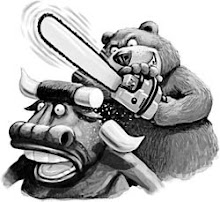Bond Head Fake
It has been an interesting two weeks in the bond market. The ten-year flirted with the key 4% level which would have indicated a breakdown in yield. A probable harbinger of "troublesome" deflation. In the long run, this may have been the preferable scenario, al least in my opinion. But in this over-leveraged world we live in, the consequences of such a development would have been worrisome to say the least. So it looks like the bonds have completed a successful test of recent lows, in yield, and we can look forward to long rates moving higher and the Fed being forced to respond at the short end of the curve, ramping rates up at their "measured pace". My call in previous rants for a Fed Funds rate higher than most anticipate was beginning to look questionable with the recent test of the 4% level, but since that level has held, I continue to anticipate that the Fed will be forced to raise rates more than most people may expect, ultimately 4.5% on the Fed Funds would be a reasonable target. With the present gearage ratio that most people embrace, that will probably be about all that the market will bear and will serve to do the job of flattening the yield curve, stabilizing the dollar and bringing the economy back down to a non-inflationary level of growth between 0-1%. By the time we get there, enough squawking about the pain of the Fed's "tightness" will be readily audible and will serve to usher in the new era of whomever will take the reins from the ignoble Alan Greenspan. I have previously forecast that the ten-year could reach a yield of 5.5%. I would now consider that more of a ceiling than a forecast, although I still think the odds are greater than 50% that we will see a spike up to that level, that could set us up for the next leg down in this bear market. The danger in this scenario is that if such a spike develops, the Fed, due to already being behind the curve, will follow this spike in long rates with a similar spike in short rates which could lead to an uncontrollable downward spiral. At this point, I would expect that a more likely scenario is that the Fed continues to raise rates slowly, until we see this spike at the long end, which may be accompanied by some dollar volatility, the Fed responds with a 50 basis point rate hike, the markets get the message and the yield curve flattens, markets weaken and we see a recession in 2006-2007 of a more normal variety, which leads to the next easing cycle and we get to do it all again. It will require a fine balancing act and a lot of luck (more and more luck is required with each of these reliquifecation cycles), but I see the potential for them pulling it off. Unfortunately, it makes it less likely and maybe even impossible, that the responsible middle road option of ZIRP (zero inflation rate policy) could be persued. This would be the best long-term solution of maintaining rates at a neutral level where the market would force some long needed reallocation of resources, inflation would fall to zero or even enter the area of deflation with a benign drop in price levels of 2% per annum or less. Instead, we are likely to muddle through for as long as possible until the boom and bust cycle either gives way to uncontrolled inflation or severe deflation or possibly both, at a time when we can least afford it. Such is the legacy of the Fed's action in the aftermath of the 1998-2000 stock bubble. It may be a legacy that all of us will have to live with for a long time to come.

